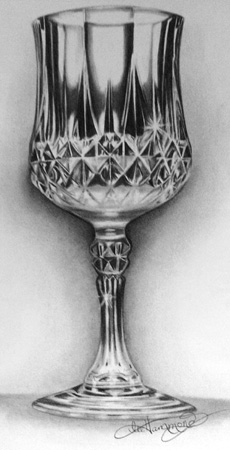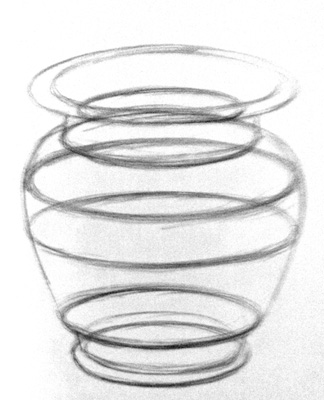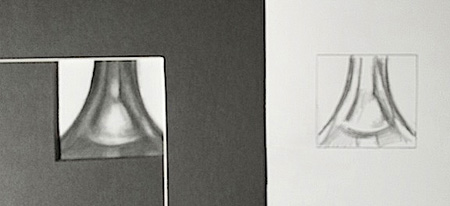How to Draw Glass: Use Your Eyes, Not Your Memory

Drawing glass, and other transparent things, is not as hard as it may seem. What makes it seem difficult is not because of the subject itself; it’s because of how we think about it. Our biggest hurdle to overcome when drawing is to overcome what our brains are telling us about the object. Rather than thinking so much, we should be observing and analyzing instead. Use your eyes, and not your memory.

How to Draw Glass
When we think of transparent things such as glass and water, our brain screams, “It’s clear!” How do you draw something that is clear? First, realize that anything that is clear is actually made up of the things surrounding it, and reflecting into it. To make it easier, quit thinking “clear,” and instead, look for the patterns of light and dark that are shown within it.
A perfect example of this theory is shown in this crystal glass. The drawing above is featured in my book, Lifelike Drawing. It shows how everything can be viewed as a combination of light and dark shapes that create a puzzle. Drawing each little shape, one at a time, simplifies the project.

Look at the example of the glass bottles. This drawing will be in my new book coming out next year titled, The New Big Book of Drawing. It shows how the look of glass can be created with smooth blending. Neither one of these bottles has perfectly clear glass. Each one of them has a tint of color to it. The one on the right is obviously much darker in color. To make these actually look like glass, I focused on the patterns of light and dark. It’s the contrast that makes them look shiny.
I drew the darker bottle on the right first, to establish my darker tones. This kept me from going too dark on the lighter one on the left. Comparing tones from one area of your drawing to another helps you with your tonal accuracy. I find it helpful to always start with the darkest area of your drawing first. Remember: Dark creates light!
I used a lot of blending with the stump to make this look smooth and reflective. I studied the patterns of light and dark, and applied the dark areas first with my pencil. After blending it smooth, I used a kneaded eraser to “lift” the light shapes and reflective highlights.

One of the crucial things about drawing still life such as this is making your subject look three-dimensional. Round objects are made up of ellipses, as seen in the illustration. This example is also from Lifelike Drawing. It shows how a vase is created with elliptical shapes. Ellipses are also what make the bottles in my drawing look symmetrical, rounded, and three-dimensional.
Another important element is in the way the light and dark areas work together. Highlights and shadows create the illusion of a front surface and a back surface on the bottles. You can see the subtle suggestion of the tabletop going through them, which makes them look clear. The curves created by the shadows and the highlights create an illusion of transparency.
Don’t be afraid to try drawing glass items. For success, look at glass subjects as shapes that are made of light and dark patterns with lots of blending and lifting.

To help see these elements, try doing a segment drawing. Isolating a small portion of a glass object with a viewfinder as seen here, can help you be more objective. This makes it easier to draw it accurately and see random shapes. This proves that art is highly psychological. The way we think interferes with how we observe something when drawing. Follow these suggestions, and you will be more proficient when drawing.
Lee
Lee Hammond has been called the Queen of Drawing. That may not be fair these days, since in addition to providing the best drawing lessons, she has also created fantastic books and videos filled with the same easy to follow acrylic painting techniques, colored pencil techniques and more. Click here to see all of the instructional books and DVDs that Lee Hammond has to offer!





Have a technical question?
Contact UsJoin the Conversation!